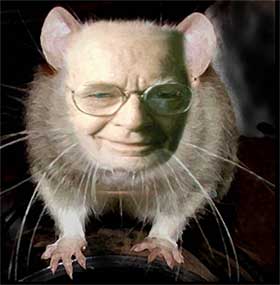B.
F. Skinner
B. F. Skinner is perhaps best known as the inventor of the operant
conditioning chamber, known to many as the Skinner Box. Born in
1904 in Pennsylvania, he grew up in a warm and stable family home.
He was an inventive child, making practical contraptions to improve
his daily life. An example of this is his Elderberry Sorter that
separated green berries from ripe ones, which he sold around the
neighborhood.
|
|
 B. F. Skinner, you dirty rat.
B. F. Skinner, you dirty rat. |
He was admonished at school by his teacher, for repeating a remark
of his father's, that Francis Bacon was the author of Shakespeare's
plays. Wanting to decide for himself, he studied Bacon's works
in the library. It was there that he discovered the inductive
method of scientific research, based on reasoning from particular
instances to a general conclusion.
He wanted to become a novelist after leaving college, but realized
that was not his forte. After an unproductive year, writing a
few articles and building models, he found work in a New York
bookshop. Here, he came across the work of Ivan Pavlov and John
B. Watson. Watson's theoretical work on behaviorism was later
tested by Skinner in the laboratory. This was to be the basis
of his reputation.
At 24 years of age, B. F. Skinner enrolled at Harvard University,
in the Department of Psychology. There, he found a mentor, William
Crozier, who was a professor in the new Physiology Department.
Skinner was left to carry out his own research, as each department
thought he was reporting to the other. With his penchant for building
apparatus, he devised his own experiments and modified them in
the light of the rats' resulting behavior. He invented the device
known as the Cumulative Recorder, that illustrated the rate of
response by rats to certain stimuli.
His work led him to his theory of "Operant Conditioning"
and a Fellowship enabled him to devote five years to researching
this theory. Operant conditioning is based on the idea that our
behavior is influenced by the outcome of the same behavior in
the past. Skinner believed that the mind and emotions played no
part in our behavior, but that it was determined purely by prior
reinforcement. This work led to his first book, "The Behavior
of Organisms", in 1938.
During the war, Skinner carried out a research project, using
pigeons to guide missiles, a project that was overtaken by radar.
Toward the end of the war, his wife set him a task of devising
a new kind of crib, after she became pregnant. He rose to the
challenge and his (then) hi-tech crib became known as the Baby
Tender. It became well known and rumors were rife that Skinner
was bringing up his daughter in a Skinner Box. The rumors were
completely untrue, as his well-balanced daughters have testified.
From 1954 B. F. Skinner turned his attention to the idea of teaching
machines, the basis of programmed learning techniques. A correct
answer gave the student a positive reinforcement, while an incorrect
answer simply presented the question over again. Much of his work
in this field is incorporated into modern computer assisted learning
techniques. In later life, he devoted his time to moral and philosophical
issues, returning to behaviorism again. He was active in his work
right up to the day he died in 1990.
Rumor Has It …
Even though B. F. Skinner did not raise his own daughter in a
Skinner Box, he did in fact, raise other people's children there.
In fact, he himself would hide out in the Skinner Box when the
missus was looking for him on Saturdays with Honey-Do jar in hand.
Written by Kevin Lepton
|

